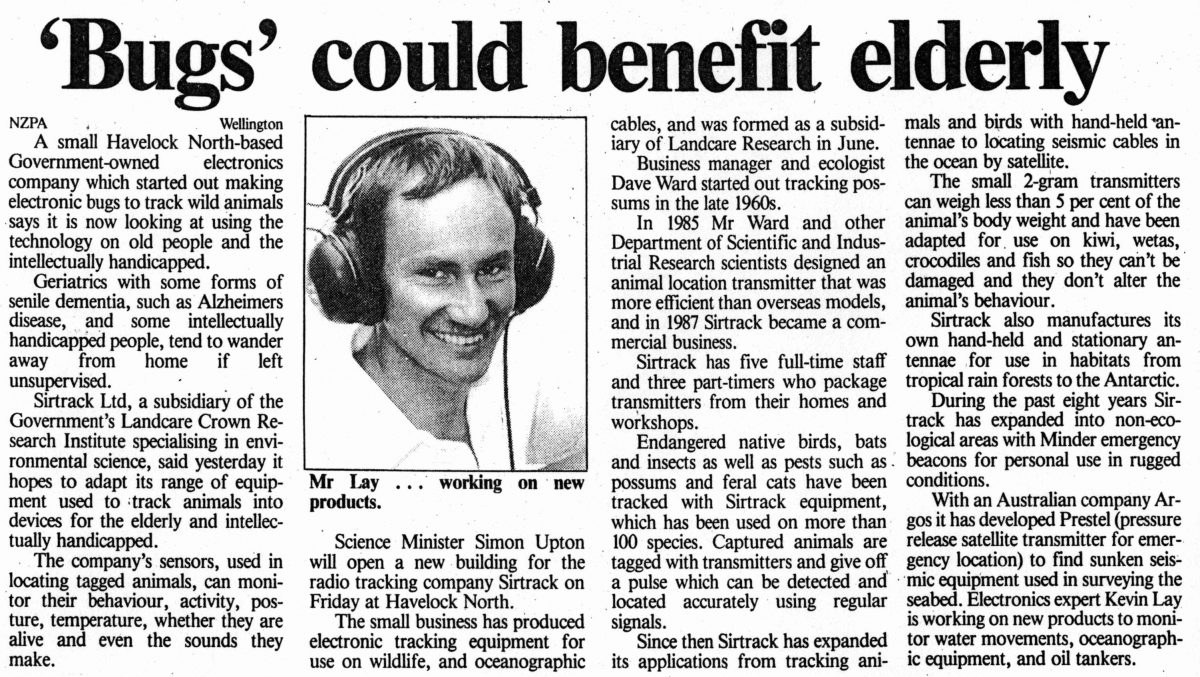‘Bugs’ could benefit elderly
A small Havelock North-based Government-owned electronics company which started out making electronic bugs to track wild animals says it is now looking at using the technology on old people and the intellectually handicapped.
Geriatrics with some forms of senile dementia, such as Alzheirners disease, and some intellectually handicapped people, tend to wander away from home if left unsupervised.
Sirtrack Ltd, a subsidiary of the Government’s Landcare Crown Research Institute specialising in environmental science, said yesterday it hopes to adapt its range of equipment used to track animals into devices for the elderly and intellectually handicapped.
The company’s sensors, used in locating tagged animals, can monitor their behaviour, activity, posture, temperature, whether they are alive and even the sounds they make.
Science Minister Simon Upton will open a new building for the radio tracking company Sirtrack on Friday at Havelock North.
The small business has produced electronic tracking equipment for use on wildlife, and oceanographic cables, and was formed as a subsidiary of Landcare Research in June.
Business manager and ecologist Dave Ward started out tracking possums in the late 1960s.
In 1985 Mr Ward and other Department of Scientific and Industrial Research scientists designed an animal location transmitter that was more efficient than overseas models, and in 1987 Sirtrack became a commercial business.
Sirtrack has five full-time staff and three part-timers who package transmitters from their homes and workshops.
Endangered native birds, bats and insects as well as pests such as possums and feral cats have been tracked with Sirtrack equipment, which has been used on more than 100 species. Captured animals are tagged with transmitters and give off a pulse which can be detected and located accurately using regular signals.
Since then Sirtrack has expanded its applications from tracking animals and birds with hand-held antennae to locating seismic cables in the ocean by satellite.
The small 2-gram transmitters can weigh less than 5 per cent of the animal’s body weight and have been adapted for, use on kiwi, wetas, crocodiles and fish so they can’t be damaged and they don’t alter the animal’s behaviour
Sirtrack also manufactures its own hand-held and stationary antennae for use in habitats from tropical rain forests to the Antarctic.
During the past eight years Sirtrack has expanded into non ecological areas with Minder emergency beacons for personal use in rugged conditions.
With an Australian company Argos it has developed Prestel (pressure release satellite transmitter for emergency location) to find sunken seismic equipment used in surveying the seabed. Electronics expert Kevin Lay is working on new products to monitor water movements, oceanographic equipment, and oil tankers.
Photo caption – Mr Lay…working on new products.












Do you know something about this record?
Please note we cannot verify the accuracy of any information posted by the community.